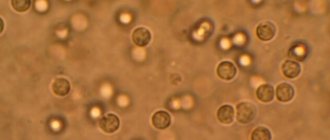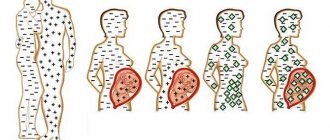Expectant mothers have to regularly conduct blood tests, which makes it possible to timely diagnose the presence of certain health problems, especially if test results show that monocytes are elevated during pregnancy. This situation raises many questions in a woman - what are monocytes, what does an increase in their number indicate, and what consequences can this lead to? In fact, a sharp increase in the number of monocytes over a long period of time most often indicates that a person has serious health problems.
What are monocytes, their role and functions in the body
Monocytes are a type of white blood cell. They make up 2-10% of the total volume of white cells. These immune bodies circulate through the bloodstream for 2-3 days, and then enter the tissues and become protective cells.
Monocytes protect the human body from viral, bacterial, fungal and parasitic infections.
Monocytes in the blood of an adult are responsible for many functions in the body.
They kill microorganisms, absorb foreign particles, remove dead cells and enhance the immune response. However, along with this, they can be involved in the development of certain diseases, for example, inflammatory lesions of the joints or blood vessels.
Count
Provides for the calculation of the leukocyte formula, including determination of the amount of MON in the blood. The absolute content of monocytes per unit volume of blood and the relative content are taken into account: the percentage of each type of leukocyte to the total number of white blood cells.
For the diagnosis of monocytes, both indicators are in demand, but the percentage ratio is more often used. It indicates the contribution of MON to the defense of the body.
The rate of monocytes in the blood of men and women of different ages is the same. For an adult, the upper limit of normal monocytes is considered to be 8 * 104 cells in 1 ml. In children, the norm of monocytes in the blood is considered acceptable to fluctuate from 5 to 11 * 10 4 in 1 ml. In percentage terms, the norm is considered to be monocytes in a blood test in men and women at the level of 3-11%, and in children from 2 to 12.
The condition in which it is called monocytosis. If the number of monocytes is less than normal, we are talking about monocytopenia.
There are absolute and relative monocytosis. Relative monocytosis is considered to be a situation when all leukocytes are increased, and absolute monocytosis is when only monocytes are increased.
A blood test detects monocytosis only at the height of the disease. Because a large number of monocytes are released into the blood after a signal is received about an increasing pathological process.
Table of the norm of monocytes in the blood by age
Monocyte levels in humans may differ by age:
| Age | Monocytes, % | ||
| Minimum indicators | Maximum performance | Average values | |
| Up to 1 month | 5 | 15 | 10 |
| 2-12 months | 4 | 10 | 7 |
| 2-6 years | 3 | 10 | 6.5 |
| 7-12 years | 2 | 10 | 6 |
| 12-18 years old | 2 | 9 | 5.5 |
| Over 18 | 3 | 11 | 7 |
These values are average for a healthy person, they can change, and this is due to lifestyle, time of day and taking various medications.
How monocytes change during pregnancy
The norm of monocytes before pregnancy is 2-8%. After conceiving a child, there is a slight increase in monocytes:
- I trimester – 3-8%;
- II trimester – 4-8%;
- III trimester – 4.5-8%.
Blood counts return to normal in the postpartum period. Slight monocytosis may persist for up to 6 weeks.
It is not known exactly why monocytes grow. The influence of human chorionic gonadotropin (hCG) is suspected. This hormone is released after the baby is conceived. Reaching a value of 100 IU/ml, it stimulates the synthesis of monocytes and enhances their phagocytic activity. But this theory explains monocytosis only in the early stages of gestation. After 14 weeks, hCG levels decrease and the increase in monocytes is due to other mechanisms.
Many researchers believe that the growth of monocytes is caused by an increase in progesterone concentrations. The main hormone of pregnancy suppresses the activity of T-lymphocytes and leads to compensatory synthesis of phagocytic cells. Monocytes increase in the blood, macrophages accumulate in tissues, including the uterus and placenta. Because progesterone levels remain high until delivery, monocytosis persists. The role of monocytes during pregnancy:
- create a pool of macrophages in the placenta;
- control the development of the placenta;
- participate in the immune response.
Monocytes in pregnant women are characterized by increased adhesion to the vascular endothelium. They quickly accumulate lipids from the peripheral blood and adhere to the vascular wall. It is assumed that monocytes may be involved in the development of endothelial dysfunction and gestosis, a dangerous complication of pregnancy.
Monocytes from pregnant women release more proinflammatory cytokines. They are more actively involved in the immune response. This explains the fact that many chronic infections and autoimmune diseases subside during gestation. After the baby is born, blood counts return to normal.
What tests help determine the level of monocytes
To find out the indicator of monocytes in the blood formula, the doctor recommends taking a clinical blood test. It gives a complete picture of human health. The remaining indicators of the leukocyte formula are important only in the diagnosis of certain diseases.
If a person has a serious infection, these rates also increase. In order for the indicators to be accurate, it is necessary to exclude food within 8 hours, and alcohol within 24 hours. Emotional stress, as well as stress, can also affect the outcome of the tests.
Changes in monocytes in pregnant women
A gynecologist is obliged to pay attention to monocytes in the blood of pregnant women. The fact is that monocytosis warns of a woman’s infection. Most often, we are talking about the flu or respiratory diseases. If the pregnant woman feels good, then problems may arise with enlargement of the submandibular lymph nodes and swelling of the throat mucosa.
Monocytopenia indicates decreased immunity. The body's inability to protect the fetus and itself from the invasion of harmful agents. Such pathologies are usually the result of an unbalanced diet of a pregnant woman, especially due to a deficiency of vitamins and iron.
When deciphering the results of blood tests, the doctor’s experience and the ability to find a connection between laboratory data and clinical symptoms are of great importance.
- The monocyte is the largest cell in the circulating blood
(about 12-22 micrometers in size), it contains a large volume of cytoplasm, which is colored dark gray (often called “cloudy sky”). The cytoplasm is distinguished by fine azurophilic granularity, which is visible only if the cell smear is sufficiently stained. - The core is quite large, has looseness
, polymorphism, in the form of a trefoil, a bean, a horseshoe, and is found in the form of an insect such as a butterfly with open wings. - The precursor of these cells (CFU-GM) is the same as granulocytes
, and the precursor of the monocytic germ is CFU-M. These cells leave the bone marrow without fully maturing, live in the bloodstream for about 20-40 hours, then they leave the peripheral circulating blood and move into tissues, where they are completely specialized. - Once the cells leave the bloodstream, they cannot return again
. Monocytes released into the tissue become macrophages (in some organs they have specific names, namely: Kupffer cells of the liver, histiocytes contained in connective tissue, alveolar, pleural macrophages, osteoclasts, microglia of the nervous system). In the living cells of organs themselves, they have the opportunity to live from a month to many years. - The movement of monocytes is similar to amoeboid
, and they also have phagocytic ability. They digest not only their own dead cells, many microorganisms and fungi, but also aging cells, such as blood elements, and infected with viruses. - Due to their functions
and structure, they destroy the focus of local inflammation and create conditions for the repair process. But in the bloodstream itself, the cells have almost no phagocytic activity. - In addition to the process of phagocytosis, monocytes have secretory and synthetic abilities
. They are able to synthesize and produce a set of factors such as “mediators” of inflammation: interferon-a, interleukins-1, -6, TNF-α.
Causes of increased monocytes in children and adults
An increased level of monocytes in adults and children is called monocytosis. It is not a separate disease, but rather refers to the consequences of pathologies in humans.
Monocytosis occurs in diseases:
- hematological tumors (leukemia or lymphoma);
- infections (viruses, tuberculosis, bacterial endocarditis, syphilis);
- autoimmune diseases (rheumatoid arthritis, scleroderma);
- sarcoidosis;
- cancer (breast, ovarian, colon);
- myocardial infarction;
- HIV infection;
- severe pneumonia;
- childbirth;
- alcoholism;
- obesity;
- depression.
In addition to diseases, an increase in the concentration of monocytes in the blood count may indicate previous infectious diseases. This indicates that immune cells continue to work to protect humans from viruses, fungi and bacteria.
Prevention measures
If the attending specialist reveals that an adult’s monocytes are elevated during pregnancy, he will prescribe an additional test that helps determine the exact cause of the disease.
It is important for an expectant mother to monitor her health. Obviously, the condition when monocytes are elevated during pregnancy is not always a pathology. Prevention of diseases that provoke undesirable disturbances in the level of protective structural units is as follows:
- you need to stop playing sports, avoid stressful situations, emotional turmoil, and feelings of malaise;
- use only those medications that were prescribed by the treating specialist and in the prescribed dosage;
- go less often to places where large numbers of people gather during periods of exacerbation of viral diseases;
- walk in the fresh air more often;
- rest more, get good sleep;
- stop eating food with food additives and substitutes, replacing it with natural products containing vitamins and nutrients.
Infections
Infections are among the most common causes of monocytosis. This is due to the appearance of pathogenic bacteria, viruses and fungi in the body, which the immune system begins to fight. The bone marrow produces a large number of monocytes, which destroy harmful microorganisms.
Monocytes are elevated in adults and children with the following infectious diseases:
- colds;
- dysentery;
- flu;
- HIV infection;
- tetanus;
- measles;
- syphilis.
There are other infectious diseases that can provoke monocytosis. These are intestinal, respiratory and skin infections that affect organs or systems of the human body.
Mononucleosis
Mononucleosis is a disease that most often affects children and is accompanied by an increase in the leukocyte count in the blood. This condition is dangerous because it can develop into nasopharyngeal cancer or other diseases. The onset of the disease occurs by airborne droplets or through the blood.
The onset and course of mononucleosis is accompanied by the following symptoms:
- temperature increase;
- nasal congestion;
- headache;
- sore throat and redness of the tonsils.
Over time, if treatment is not started, more severe symptoms may appear, which include:
- mononucleosis rash;
- increase in the size of the liver and spleen.
A blood test indicates mononucleosis if the level of monocytes, lymphocytes, neutrophils and basophils is high. This condition requires immediate treatment, as there is a possibility of complications.
This is interesting: Bacteriological urine analysis: indications for performance and evaluation of results
Pediatric infectious diseases
Monocytosis in a child can be a consequence of infectious diseases. Such pathologies occur mainly during childhood. After treatment, strong immunity appears that lasts throughout life.
Pediatric infectious diseases that increase the concentration of monocytes include:
- rubella;
- mumps;
- chicken pox;
- whooping cough;
- measles.
All these diseases are caused by infectious bacteria that infect the body. In response, the immune system begins to produce additional monocytes to effectively fight pathogenic bacteria.
Tuberculosis
Tuberculosis is a pathological condition caused by infectious bacteria. A high level of monocytes in this pathology occurs only in subsequent stages of the disease.
In the first clinical studies, the indicators may not deviate from the norm. This is the difficulty of diagnosing this disease.
However, sometimes tuberculosis bacteria can behave nonspecifically. In some cases, white cell levels may increase by 10-20%. If primary severe tuberculosis develops, the white blood cell count drops.
Parasites
Monocytes are elevated in adults and children if there is a possibility of parasites existing in the human body. First of all, this is due to the enhanced actions of the immune system. The bone marrow produces more white cells to fight parasitic microorganisms.
The presence of parasites in the human body is not accompanied by any symptoms, but the blood count shows an increase in the concentration of monocytes.
The main parasites that increase monocyte levels include:
- helminths;
- protozoan organisms;
- ectoparasites.
These parasites live at the expense of their host and are regarded by the immune system as enemies. Therefore, protective cells try to destroy them, and the bone marrow helps produce monocytes.
Chronic infectious inflammation
Monocytosis can also be caused by persistent infectious diseases. Chronic inflammation causes changes in the leukocyte formula. A person may not notice any symptoms for a long time, but there may be deviations from the norm in the blood test.
Chronic inflammation that can provoke an increase in the number of monocytes includes:
- herpes;
- shingles;
- cytomegalovirus infection;
- papillomas;
- chlamydia.
Typically, chronic inflammation lasts for months and does not have an acute onset of the disease. However, from the first days of inflammation, the body begins to produce an increased number of monocytes, which is an indicator of the presence of pathology.
Autoimmune diseases
Since in autoimmune diseases, the body perceives its own cells as enemy cells, it produces an increased number of monocytes. However, autoimmune inflammation that occurs against the background of the destruction of healthy cells may not always be accompanied by an increase in the number of monocytes. All indicators depend on the general condition of the body and its immunity.
Autoimmune diseases include:
- lupus erythematosus;
- scleroderma;
- rheumatoid arthritis.
When the immune system is active, it produces huge numbers of white cells to fight pathogens. However, in cases of weak immunity, the concentration of monocytes may decrease.
Oncohematological disease
Oncological lesions of the blood are often accompanied by a transformation of the blood composition. Tumors in the hematopoietic system are perceived by protective cells as hostile, and as a result, all indicators of the leukocyte formula increase.
The oncohematological group of diseases includes:
- leukemia;
- lymphomas.
In addition to an increase in the number of monocytes, during oncohematological disease, their concentration may also decrease. This is due to the nonspecific action of tumor cells.
Malignant tumors
A blood test is an important test for diagnosing cancer. Typically, with malignant tumors, the concentration of monocytes increases as the immune system turns on the defense mode. However, with bone marrow cancer, the rate may, on the contrary, fall. This is due to a weak immune response and a malfunction of the bone marrow.
Monocytes are elevated in an adult if the following malignant tumors are present in the body:
- stomach cancer;
- ovarian cancer;
- lungs' cancer;
- adrenal cancer;
- breast cancer;
- colon cancer.
Elevated monocyte counts may indicate the presence of cancer, so it is important after the analysis to consult a doctor for further diagnosis and to determine the reasons for the deviation from the norm.
Chemical intoxication
Chemical poisoning greatly affects a person’s blood composition. During the occurrence of intoxication, not only the leukocyte formula will change, but also other blood parameters, such as lymphocytes and erythrocytes. The number of monocytes in the blood decreases as the immune system is blocked.
The most common chemicals that cause poisoning with changes in blood composition:
- detergents and cleaning products;
- shampoos;
- vinegar;
- cosmetics;
- ammonia;
- pesticide;
- paints.
Most often, it is children who suffer from intoxication. In case of poisoning, immediate medical attention is required.
Main function of monocytes
As mentioned above, a type of leukocyte cell such as monocytes is involved in protecting the body from the effects of foreign pests. In appearance, these are white cells that capture and destroy foreign cells. Moreover, the most capable of phagocytosis (destruction of pest cells) are immature monocytes. When pathogens enter the body, they actively resist them, inactivating foreign cells, such as pathogenic microbes or dangerous protein fractions.
In addition, monocytes:
- remove destroyed leukocytes from the body;
- accelerate the active production of interferons;
- take part in the formation of blood clots;
- have an antitumor effect on the body.
Based on this, we can safely say that monocytes are a dangerous obstacle to the further progress of the infection.
If other blood cells, namely lymphocytes and eosinophils, die instantly when meeting dangerous bacteria, then monocytes begin an active fight. It is this property of monocytes that lies in their importance for the human body. Symptoms of monocytosis - often it is possible to find out about the presence of monocytosis not so much by personal feelings as by blood test results. However, doctors identify several symptoms that are characteristic of this condition and indicate serious health problems.
These symptoms include:
- fast fatiguability;
- constant feeling of weakness;
- chronic fatigue;
- low-grade fever – it stays at 37-37.5°C for a long time.
If such conditions occur, it is necessary to consult a doctor for timely diagnosis and treatment.
Reasons for increased rates in women: menstruation, pregnancy
The monocyte count in women is usually higher than in men. This is due to monthly blood loss during menstruation. There is also a psychological factor: women are more emotional than men, and nervous outbursts can cause an increase in monocytes.
This is interesting: Treatment of head lice in children. Preparations, folk remedies, medicines
The leukocyte formula in women can change under the influence of the menstrual cycle:
- During the follicular phase, the number of monocytes may be lower than usual, as endometrial detachment occurs and the woman loses some blood.
- Ovulation is characterized by an increase in indicators to normal values.
- During the luteal phase, the number of monocytes increases as the body prepares for endometrial detachment and repeated blood loss.
During pregnancy, the composition of the blood can change, so pregnant women have their own normal values. Typically, elevated monocyte levels during this period are not accompanied by any symptoms. Immunity activates the forces for bearing and protecting the fetus. Indicators may differ from the norm by 2% (the norm for pregnant women is from 1 to 11%).
Deviation of monocyte content from the norm in children
In children, monocytosis often accompanies infectious processes, especially viral ones. After all, children get colds more often than adults. The presence of monocytosis indicates that the child’s body is entering the fight against infection.
Although such a serious disease as tuberculosis is rare in childhood, it can also cause an increase in the level of monocytes.
An even more dangerous reason for the growth of this group of leukocytes is oncological diseases such as leukemia and lymphogranulomatosis.
Sometimes an increase in the concentration of monocytes can be explained by the loss of primary teeth or their appearance. Individual characteristics of babies are also quite possible, the manifestation of which is a slightly increased specific gravity of these cells in the blood.
Relative monocytosis may be a reflection of already experienced illnesses and malfunctions in the body, stress experienced in the recent past.
In newborn babies, the level of monocytes in the blood is always elevated. Therefore, a deviation from the norm of up to 10% is not considered a pathology, and the baby does not need additional examination.
Monocytopenia in children is more common than monocytosis. Cell content can drop to zero after the baby has suffered:
- injury;
- negative stress;
- surgical operation.
Long-term treatment with certain drugs also provokes a decrease in the level of monocytes in children's blood.
Monocytopenia can be a symptom of complete loss of strength, exhaustion of the body and its low resistance.
Whatever the reasons for the deviation of the level of monocytes from the norm, the child’s body needs a full examination. There is no point in treating monocytosis or monocytopenia on your own.
Often, along with a deviation from the norm in the level of monocytes, the same happens with other blood cells, in particular with other groups of leukocytes. But they are the ones who stand guard over the body, protecting it from the occurrence of various pathologies. Therefore, in case of an abnormal number of protective cells, it is necessary to urgently consult a doctor. He will prescribe additional tests and, if necessary, effective therapy.
Monocytes (MONO) are cells of the circulatory system that belong to the leukocyte series. They are the largest representatives of the leukocyte family.
The formation of these cellular elements occurs in the bone marrow cells, from where they enter the blood. After a few days, they migrate from the blood into tissues, in which they become mature macrophages (they acquire the ability to absorb foreign particles). Monocytes are found in large numbers in the cells of the lymph nodes, liver and spleen.
Main functions of monocytes:
To determine the number of monocytes, a general blood test with a complete leukocyte formula is prescribed. This diagnostic method is carried out by collecting capillary blood from a finger or by taking venous blood. A general blood test is recommended for all patients visiting a clinic or hospital.
Preparing for a blood test to determine your monocyte level
Preparing for a general blood test does not require adherence to strict preparatory rules. The patient is advised to come for blood donation in the morning on an empty stomach. The term “on an empty stomach” means limiting food intake at least four hours before the procedure. In addition, you should avoid fatty and fried foods and drinking alcohol on the eve of the test. It is worth protecting yourself from unnecessary stressful experiences or increased physical activity some time before the procedure.
Symptoms of increased monocytes in women and men
The symptoms of an increased number of monocytes depend primarily on the underlying disease. Because a high white blood cell count is a clinical indicator and not a disease, it may be accompanied by symptoms of the underlying cause. However, there are atypical cases when an increased rate may have no symptoms at all.
As the immune system begins to fight viruses and bacteria, the main symptoms may be similar to those of a cold:
- weakness;
- temperature increase;
- headache.
These general symptoms accompany most infectious diseases with increased monocyte levels.
Symptoms of monocytosis
Symptoms of monocytosis are: general weakness, fatigue and fever. Sometimes other signs characteristic of the disease that causes monocytosis may be present. Additional research is always required to confirm the diagnosis.
In addition to a blood test, they use the collection and study of the patient’s medical history, ultrasound examination of organs, MRI and CT, general and chemical analysis of blood, urine and feces, sputum examination, and vaginal smear.
If the increase in monocyte cells occurred in connection with physiological processes, then the prognosis is favorable. However, if diseases of other organs and systems are to blame, then the degree of the disease itself must be taken into account. The complications of monocytosis will depend on this.
Any serious illness during pregnancy can lead to miscarriage, infection of the fetus, retarded physical development, termination of pregnancy, difficulties during childbirth, disability and death.
Additional diagnostics: analysis for lymphocytes, ESR, neutrophils
The clinical blood test immediately includes indicators such as lymphocytes, ESR and neutrophils. This data allows the doctor to more accurately diagnose and prescribe treatment.
Deviations from the norm of two or more indicators indicate the presence of pathological changes in the body:
- Changes in the concentration of monocytes and lymphocytes indicate, first of all, a bacterial infection.
- Abnormalities in ESR and monocytes are typical for viral and autoimmune diseases.
- An excess of neutrophils and monocytes may be the cause of fungal infection.
In case of serious illnesses in the body, several deviations in the blood formula usually appear. Each disease has its own characteristics of changes.
When is monocytosis diagnosed?
Relative monocytosis is diagnosed if their number is more than ten percent of the total number of leukocytes. This occurs in the presence of neutropenia and lymphocytopenia. This condition is not a threat to the body, unlike the absolute form, which indicates an active immune response of the body in case of serious abnormalities. A similar process can occur with malaria, brucellosis, syphilis, viral infections, and parasitic diseases. Sometimes this occurs in the presence of malignant diseases, such as leukemia, lymphoma, lymphogranulomatosis. The fact is that in the presence of oncological tumors, their values increase in the initial stages, which serves as the very first signal about such a disease. After gynecological operations, women may experience such changes in the composition of their blood.
Monocytes are white cells that are produced by the bone marrow.
The reasons for the appearance of such a process can be very different. During pregnancy, any deviations in the chemical composition of the blood can have a detrimental effect on gestation and fetal development. To prevent serious problems, you should constantly undergo examinations and tests.
Ways to normalize monocyte levels
Monocytes are elevated in an adult or child, most often if there is any disease. Therefore, to normalize, the doctor must prescribe therapy for the underlying disease. If the cause of the deviation is a bacterial infection, then complex treatment includes the use of antibiotics.
As for viral or parasitic lesions, antiviral or antiparasitic treatment is prescribed accordingly.
In the case of cancer and autoimmune diseases, therapy is aimed at the underlying disease. During pregnancy, monocyte levels are elevated due to increased immune system function. During pregnancy, the leukocyte formula does not require normalization, as this is considered a physiological condition. After childbirth, normal levels are restored.
Monocytes and pregnancy
In the blood fluid of expectant mothers, fewer monocytes are usually found than before conception. The ratio of cells changes as a result of reformatting of the immune system and the endocrine system. Change is a physiological phenomenon. The restructuring is needed to ensure the development of the embryo: if the body continues to work in the same format, fetal rejection may occur. The norm of monocytes in position is 1 – 11%. When compared with the norm for non-pregnant women, the lower figure decreases by as much as three times.
If monocytes grow quantitatively during pregnancy, exceeding the upper limits, most likely the mother is attacked by harmful agents - viruses, infections. When the indicators change slightly, the body has coped with the load on its own. However, if the increase is significant and observed for a long time, you need to look for the cause and take action.
Sometimes overestimated values may be a variant of the norm. But this is only possible in the first gestational months. The condition is caused by natural physiological changes. The body needs time to adapt to the new position. At first, the immune system may mistake the fetus for a harmful element. As a result, the production of protective cells will increase. By the second trimester, the indicator usually returns to normal: now the embryo is not considered a foreign agent.
Prevention of monocytosis
To avoid elevated monocyte levels, you must follow your doctor's recommendations for treating the underlying disease.
Methods for preventing monocytosis also include:
- giving up alcohol;
- regular exercise;
- weight loss for overweight and obesity;
- consumption of omega-3 fatty acids;
- reducing meat consumption in the diet.
These simple methods of prevention will not only help prevent an increase in monocytes, but also prevent many diseases.
Causes of monocytosis
In an “interesting situation,” an increase in the number of monocytes can be provoked by various pathologies. Monocytosis is observed with:
- viral infections,
- bacterial diseases,
- diseases of the hematopoietic system,
- autoimmune disorders,
- oncology,
- malaria,
- tuberculosis,
- gastrointestinal diseases,
- lupus,
- syphilis,
- collagenosis.
This condition can be provoked by various factors unrelated to disease. For example, you can expect an increased level of protective cells in the blood fluid after stress. Moreover, the reaction occurs with lightning speed: mommy got nervous - the indicator jumped. Overfatigue also affects the number of leukocyte elements: the value increases due to excessive physical activity.
Even in the early gestational stages (when the growth of monocytes may be normal), an increased content of protective bodies requires a thorough examination of the mother. This condition may indicate the start of a pathological process. It is important not to miss the problem and start therapy in a timely manner, if necessary. Early diagnosis reduces the likelihood of serious complications.
Experts' forecast for elevated monocytes
The prognosis for elevated monocytes primarily depends on the cause of their occurrence. If the underlying disease is an infection, then competent therapy can completely cure and reduce the indicators.
If the root cause of the deviation in indicators is cancer, recovery depends on many factors, such as the stage of the disease, age, or the presence of concomitant diseases. In women, changes in monocyte levels can occur under the influence of pregnancy or during different menstrual phases.
Monocytosis is not a disease and therefore does not require special treatment. Therapy, first of all, should be aimed at eliminating the root cause. Preventive methods for monocytosis include maintaining a healthy lifestyle, giving up bad habits, proper nutrition with a reduced meat content, as well as treatment of emerging infections.
Monocytes can be elevated in adults and children during infectious diseases of a viral, bacterial or fungal nature. In addition, deviations in the leukocyte formula may indicate the presence of cancer or autoimmune diseases.
Article design: Oleg Lozinsky
Other reasons
Another fairly common reason for a violation of the number of monocytes, as many experts say, is the presence of parasites in a woman’s body. It is important to undergo blood tests in a timely manner to identify them:
- if the level of monocytes deviates slightly from the norm, then the treating specialist can independently reduce the impact of pathogenic bacteria on the body;
- in case of strong deviations from the normal state, it is important for a woman to undergo comprehensive treatment that will help normalize previous indicators.
It is important to remember that monocytosis is not a disease. It signals that some kind of ailment is developing in the human body during this period of time, which requires mandatory treatment. It is important to eliminate the cause of monocytosis as early as possible in order to get rid of the pathological process in a short time.
Laboratory diagnostics
An increase in protective elements in the blood can only be detected using a general analysis. Cells in the blood fluid are measured on an absolute scale and their ratio to other leukocyte elements is taken into account. To obtain accurate data, you must follow these rules:
- do not eat food at least eight hours before going to the laboratory;
- do not drink anything other than small amounts of still mineral water;
- do not be nervous on the eve of blood collection;
- the day before the analysis, exclude any physical activity.
The analysis is scheduled for the morning. If you move it to another time of day, the results will be distorted. Reliability is affected by medications, alcohol, smoking, and recent stress. An important factor is the competence of the laboratory assistant. The collection of blood fluid must be carried out correctly, and the necessary preservatives must be used during the study. If you have doubts about the actions of the laboratory workers, you can always go to another place for a repeat test.
If an increased level of monocytes is detected and in the absence of symptoms characteristic of any disease, the doctor prescribes additional tests. They take sputum for analysis, you need to do a smear from the vagina, an ultrasound of the organs, and an MRI may be required. The list of studies depends on the patient’s medical history, the general clinical picture - everything is individual and at the discretion of the doctor.
Treatment
An increase in monocytes is a signal of disease. The main thing is to identify the disease that provoked this phenomenon. Therapy directly depends on the diagnosis. A pregnant woman may be prescribed:
- Drug treatment. The doctor selects medications taking into account the gestational age. He weighs the possible risks and prescribes the safest medications.
- Diet therapy. It is needed to support the body, which is fighting the disease.
- A course of vitamins. Attack from harmful agents weakens the immune system. Vitamins help restore the protective barrier.
Depending on the disease, specific treatment may be required. For example, surgery, physical therapy, blood transfusion. If a pronounced clinical picture is present, measures should be taken to relieve unpleasant manifestations. Whether the treatment will be inpatient or home is determined by the obstetrician-gynecologist. It all depends on the diagnosis, severity of symptoms, and general well-being of the patient.
The expectant mother must follow all the instructions of the attending physician. It is strictly forbidden to make decisions regarding treatment on your own. It is easy to harm a baby with rash actions, but it is impossible to return everything back.
The easiest way to bring the level of monocytes back to normal is in case of viral and infectious diseases detected in the early stages. If the number of cells has increased slightly, then drug therapy may not even be required: such indicators mean that the mother’s body has coped with the problem itself. The doctor recommends taking vitamin therapy to help restore immune function.
The most difficult treatment involves cancer and chronic leukemia. If the increase in monocytes is caused by these particular ailments, therapy will be long and complex. No doctor can guarantee a complete recovery in such cases.
What level is considered elevated for pregnant women?
An increase in the level of this component can cause a decrease in immunity
, but at the same time monocytes release anti-inflammatory substances into the blood.
Monocytes are part of the biological material of every person and occupy approximately ten percent of all leukocytes. They move in liquid and perform their main function - they devour harmful bacteria that have entered the patient’s body from the outside. These are a kind of “cleaners of the body.”
A standard analysis will help determine whether monocytes in the blood are elevated, decreased, or normal. It is also worth noting that their normal content in the liquid depends, for example, on the age of the patient. So the monocytes in the blood of a child over thirteen years old are normal - from three to eleven percent. And before this age - from two to twelve.
It is very important to monitor the amount of these substances in children. Since, for example, the fact that monocytes are elevated in a child’s blood can become a signal from the body that some disease has begun to develop in it. A blood test will help you do this - in this case, monocytes will be determined very accurately. It is carried out in a standard way. At the same time, doctors recommend taking it from time to time, even if the little patient is not bothered by any symptoms - for the purpose of prevention.
Of course, monocytes can also be detected in the blood of adults; the norm in this case will naturally differ from that of children.
Increased monocytes in the blood: reasons
The reasons for this can be very different and most of them are very dangerous for the human body. Among them:
- syphilis;
- all kinds of diseases, including leukemia, which is extremely difficult to cure completely;
- Also, an increase in monocytes in the blood can be caused by various viral and fungal infections;
- rheumatoid arthritis, lupus erythematosus, sepsis, polyatritis;
- tuberculosis; - poisoning with tetrachloroethane and/or phosphorus.
There is another situation when monocytes in the blood are low. In this case, the cause may be recent childbirth, anemia, acute infectious disease, stress or strong emotions, as well as taking a glucocorticoid.
Since in both cases the causes are generally very dangerous and serious, if the content of monocytes in the blood has changed, it is necessary to seek help from a specialist as soon as possible who will help understand the cause of this phenomenon.
Several more reasons should be added to this extensive list that can increase the number of monocytes in the blood, both in adults and in children.
When the test results show a deviation from the norm, this does not always mean that an increased level of monocytes in the blood will require complex long-term treatment. Sometimes it is enough just to stop taking the drugs that cause this problem or simply restore the body's strength and improve nutrition.
Of course, self-medication is strictly contraindicated. Only an experienced doctor will be able to tell the patient in detail what monocytes in the blood mean and how to deal with changes in their levels.
First of all, you will need to find out the exact cause of the problem, and then, based on it, choose the appropriate therapy. As a rule, having established an increased level of monocytes in the blood, the doctor prescribes the person to take certain medications, as well as, possibly, additional physiotherapeutic procedures.
Monocyte norms during pregnancy
Under normal conditions, the concentration of monocytes in the body of a pregnant woman increases compared to the blood of a non-pregnant woman. The increases are physiologically explainable. The following indicators are considered normal:
- First trimester – 3-6% in the total leukocyte formula.
- Second trimester – 4-6% in the total leukocyte formula.
- Third trimester – 4-5% in the total leukocyte formula.
Whereas for a non-pregnant woman the normal figure is 3-11%.
Symptoms and signs of monocytosis
Clinical picture of monocytosis
A pregnant woman feels constant fatigue, weakness, and possibly dizziness. Her temperature rises to 37–37.5 degrees.
If the increase is insignificant, then the body is able to cope with the disease on its own, but serious deviations require treatment from a doctor.
In addition, a pregnant woman may be bothered by body aches and joint pain.
Often, patients do not pay attention to such symptoms, considering them the beginning of a mild cold, and consult a doctor when the symptoms of the disease do not go away and become stronger.
What are monocytes?
Monocytes are a blood component produced by the bone marrow. They are produced to participate in the body's immune defense process. This is a specific type of leukocyte. Their activity makes it possible to protect organs and systems from viruses, infections, etc.
Exceeding the concentration of this component indicates the occurrence of a disease process in the body of an autoimmune, metabolic, inflammatory nature. The condition of increased levels of monocytes is called monocytosis. There are two types of this pathology:
- The absolute type is spoken of when the concentration of monocytes in the body is more than 0.7x109/l.
- Relative is a condition when the concentration in the blood is still normal, but in the general leukocyte formula their number is increased (that is, this particular type of leukocyte becomes more numerous compared to others, although their total concentration does not change). Doctors begin to talk about this condition when there are 8-10% more monocytes than other types of leukocytes.
The absolute indicator has the greatest diagnostic value. It is this that indicates an active immune response to the actions of any pathogen - that is, to an ongoing pathological process. The relative indicator does not have any particular diagnostic significance.











